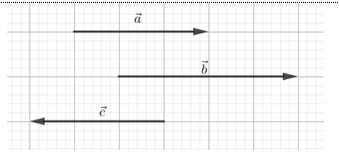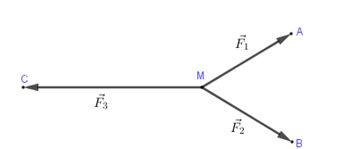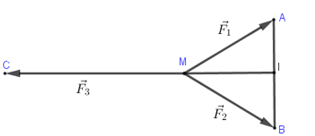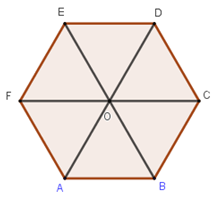Cho ba vectơ →a,→b,→c đều khác vectơ – không. Trong đó hai vectơ →a,→b cùng hướng, hai vectơ →a,→c đối nhau. Khẳng định nào sau đây đúng ?

Quan sát hình vẽ trên ta thấy hai vectơ →b,→c ngược hướng.
Cho các điểm phân biệt A,B,C,D,E,F. Đẳng thức nào sau đây sai ?
Ta có: →AB+→CD+→EF=→AF+→ED+→BC
⇔→AB−→AF+→CD−→BC+→EF−→ED=→0⇔→FB+→DF+→CD+→CB=→0⇔→DB+→CD+→CB=→0
⇔→CB+→CB=→0
⇔2→CB=→0 (vô lý) nên A sai.
Tương tự với các đáp án B, C, D ta sẽ thấy các đáp án đó đều đúng.
Gọi G là trọng tâm tam giác vuông ABC với cạnh huyền BC=12. Vectơ →GB−→CG có độ dài bằng bao nhiêu?

Ta có: →GB−→CG=→GB+→GC=2→GE=23→AE (Vì →GE=13→AE).
⇒|→GB−→CG|=23|→AE|=23.BC2=BC3=4
Cho tam giác đều ABC cạnh a, gọi G là trọng tâm. Khi đó giá trị |→AB−→GC| là:

Ta có:
|→AB−→GC|=|→AC+→CB+→CG|=|→AG+→CB|=|2→GH+2→HB|
=2|→GH+→HB|=2|→GB|=2GB=2GA=2.23AH=43.a√32=2a√33.
Chỉ ra vectơ tổng →MN−→QP+→RN−→PN+→QR trong các vectơ sau:
Ta có: →MN+→NP+→PQ+→QR+→RN=→MN.
Cho bốn điểm A,B,C,D phân biệt. Khi đó vectơ →u=→AD−→CD+→CB−→AB bằng:
Ta có: →u=→AD−→CD+→CB−→AB=→AD−→AB+→CB−→CD=→BD+→DB=→0
Gọi B là trung điểm của đoạn thẳng AC. Đẳng thức nào sau đây là đúng?

Ta có: →AB−→BC=→AB+→CB=→0.
Cho tam giác ABC, trọng tâm là G. Phát biểu nào là đúng?
Ta có: |→GA−→BG−→CG|=|→GA+→GB+→GC|=|→0|=0.
Cho tam giác ABC. Để điểm M thoả mãn điều kiện →MA−→MB+→MC=→0 thì M phải thỏa mãn mệnh đề nào?
Ta có: →MA−→MB+→MC=→0⇔→BA+→MC=→0⇔→MC=→AB
Vậy: M là điểm sao cho tứ giác BAMClà hình bình hành.
Cho ba lực →F1=→MA,→F2=→MB,→F3=→MC cùng tác động vào một vật tại điểm M và vật đứng yên. Cho biết cường độ của →F1,→F2 đều bằng 100N và ^AMB=600. Khi đó cường độ lực của →F3 là:


Vật M đứng yên ⇔→F1+→F2+→F3=→0
Hay →MA+→MB+→MC=→0
Gọi I là trung điểm của AB ⇒2→MI+→MC=→0⇔→MC=−2→MI⇒MC=2MI
Gọi I là trung điểm của AB.
Vì MAB là tam giác đều nên MI=MA.√32=50√3.
Vậy MC=2MI=100√3N
Vậy: →F3 có cường độ 100√3N.
Cho lục giác đều ABCDEF và O là tâm của nó. Đẳng thức nào dưới đây là đẳng thức sai?

Ta có:
→OA+→OC−→EO=→OB+→OE=→0⇒Ađúng→BC−→EF=→BC+→FE=→AO+→OD=→AD⇒Bđúng→OA−→OE=→EA→EB−→OC=→EB+→CO=→EB+→BA=→EA⇒→OA−→OE=→EB−→OC⇒Cđúng
→AB+→CD−→EF=→AB+→BO−→OA
=→AO−→OA=2→AO≠→0
Hay D sai.

